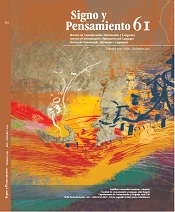Abstract
In the global and complex scenario of today, the model of e-learning for higher education, for a Master in information and documentation, seeks to apply a variety of strategies for education that are different to the traditional academic practice. The research identifies types of learning according to the VARK test along with the pedagogic use of Social Network Analysis (SNA). Following a systemic approach, the research seeks to implement training devices through the analysis and interpretation of data, which link the academic dimensions of the MA programme, and the learning styles and social networks, using Pajek.
Amador Bautista, R. (2010). Modelos de redes de educación superior a distancia en México. Revista Electrónica Sinéctica, (34), 1-13. Recuperado de http://redalyc.uaemex.mx/src/inicio/ArtPdfRed. jsp?iCve=99815691006.
Coleman, J. S. (1988). Social capital in the creation of human-capital. American Journal of Sociology, 94, suppl., 95-120.
Curry, D. L. (1983). An organization of learning style theory and constructs (p. 28). En: Curry, D. L. (Ed.). Learning style in continuing medical education. Ottawa, Ontario: Council on Medical education, Canadian Medical Association.
Fleming, N. D. &, Mills, C. (1992). Not another inventory, rather a catalyst for reflection. To improve the Academy, 11, 137-155. Recuperado de http://www.ntlf.com/html/lib/ suppmat/74fleming.htm.
Hanneman, R. A. (2001). Introducción a los métodos de análisis de redes sociales. Californa: Departamento de Sociología de la Universidad de Riverside.
Honey, P. & Mumford, A. (1986). The manual of learning styles. 2nd Ed. s. l.: Publisher, Peter Honey.
Keefe, J. (1988). Aprendiendo perfiles del aprendizaje: manual de examinador. Reston, VA: Asociación Nacional de Principal de la Escuela de Secundaria.
Kolb, D. (1984). Experiential Learning: experience as the source of learning and development. Toronto: Prentice Hall.
Legendre, R. (1993). Dictionnaire actuel de l’Éducation. Canadá: Guérin.
Nooy, W. de, Mrvar, A. & Batagelj, V. (2005). Exploratory network analysis with pajek. CUP, Cambridge University Press. Recuperado de http://bookdownloadfree.blogspot. com/2010/07/exploratory-social-networkanalysis.html.
Organización de las Naciones Unidas para la Educación, la Ciencia y la Cultura (UNESCO). (1998). La educación superior en el siglo XXI: visión y acción. Declaración mundial sobre la educación superior en el siglo XXI: visión, acción y marco de acción prioritaria para el cambio y desarrollo de la educación superior aprobados por la Conferencia Mundial sobre la Educación Superior. Recuperado de: http:// www.unesco.org/education/educprog/wche/ declaration_spa.htm.
Page-Lamarche, V. (2004). Estilos de aprendizaje y rendimiento académico en los cursos en línea. (Tesis doctoral, Universidad de Montreal, Montreal).
Pinto, A. L., Moreiro González, J. A. & Gusmão, A. O. M. (2009). Análisis de redes sociales a partir de recursos web y de bases de datos especializadas en literatura científica. Anales de Documentación, 12, 139-158.
Ponton, R. D. (1975). Birth of psychological novel: cultural capital, social capital and literary strategy at end of 19th-Century. Actes de la Recherche en Sciences Sociales, (4), 66-81.
Rose, A. (1961). Housing and social capital. Canadian Journal of Economics & Political Science, 27(1), 123-125.
Sauvé, L., Nadeau, J. R. & Leclerc, G. (1993). Le profil d’apprentissage des étudiants inscrits dans un certificat de cycle offert à distance et sur campus: une étude comparative. Revue de l’enseignement à distance, 8(2), 19-135.
UNESCO. (1998). La educación superior en el siglo XXI: visión y acción. Recuperado de http:// www.unesco.org/education/educprog/wche/declaration_spa.htm.
Unión Europea. (2007). Análisis de estilos y estrategias de aprendizaje. Programa Europeo de formación para el Aprendizaje de Adultos. Recuperado de: http://www.google.com.co/url?sa=t&rct= j&q=&esrc=s&source=web&cd=1&ved=0CC sQFjAA&url=http%3A%2F%2Fwww.faea. es%2FG1_SKILLS%2Fproducts%2Fes%2F Learning_Styles_and_Strategies_ES.pdf&ei =fGtCUNm4MuW66AHOloDIAQ&usg=AF QjCNEnQ32bAKtayB3KezmZuFwK51i_KQ
This journal is registered under a Creative Commons Attribution 4.0 International Public License. Thus, this work may be reproduced, distributed, and publicly shared in digital format, as long as the names of the authors and Pontificia Universidad Javeriana are acknowledged. Others are allowed to quote, adapt, transform, auto-archive, republish, and create based on this material, for any purpose (even commercial ones), provided the authorship is duly acknowledged, a link to the original work is provided, and it is specified if changes have been made. Pontificia Universidad Javeriana does not hold the rights of published works and the authors are solely responsible for the contents of their works; they keep the moral, intellectual, privacy, and publicity rights.
Approving the intervention of the work (review, copy-editing, translation, layout) and the following outreach, are granted through an use license and not through an assignment of rights. This means the journal and Pontificia Universidad Javeriana cannot be held responsible for any ethical malpractice by the authors. As a consequence of the protection granted by the use license, the journal is not required to publish recantations or modify information already published, unless the errata stems from the editorial management process. Publishing contents in this journal does not generate royalties for contributors.


